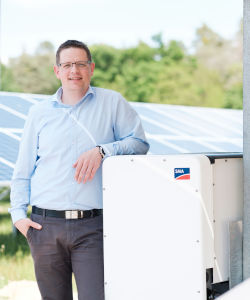The PV industry is using high-current modules to combat rising system costs. This type of module consists of M10 or larger PV cells, which can accommodate correspondingly high MPP currents (>12 A).
 Inverters for High-current Modules: the Great IDC Max Misconception
Inverters for High-current Modules: the Great IDC Max Misconception

Anke Baars | SMA America
When it comes to choosing an inverter, the I SC PV short-circuit current (“SC” stands for “short circuit”) is always the deciding factor. This value indicates the highest electrical current that a PV cell or PV module can deliver. The short-circuit current is specified on the datasheet, in the manual and on the type label for every PV input on an inverter and adhering to it is mandatory for ensuring electrical safety and complying with the warranty.
Difference between short-circuit current and maximum direct current
The value for short-circuit current determined for a PV array must fall below the limiting value for the inverter, with due consideration given to the PV modules and additions or deductions resulting from local conditions such as orientation, solar irradiation, temperature, etc.
By contrast, the I DC max value indicates the maximum current that the inverter is capable of receiving from the PV array. This is often erroneously used as the relevant variable for the maximum short-circuit current (see interview with Mathias Strippel below). Should the MPP current of the PV array exceed the maximum input current (I DC max.) of the inverter in a particular system design, there will not be any potential for damage to the inverter. Exceeding the MPP current therefore also has no impact on the inverter’s statutory warranty. All that may occur as a result are minimal yield losses, but these are negligible in most cases.
Definition of I DC max: maximum current that the inverter can receive from the PV array.
To avoid the common misconceptions surrounding the parameters relating to inverters, SMA is now including an additional note in its information regarding maximum direct current on inverter datasheets:
“Max. input current” à “Max. usable input current (I DC max)”
The reliable Sunny Design planning software, available free of charge, allows the potential impact on energy yield to be calculated in a way that is clear and easy to understand.
We have produced some examples of variations in different locations (see table). It is noticeable that exceeding the MPP current does not have any appreciable impact on the total yield of the PV system.
Here’s something that’s good to know: SMA inverters can be oversized by as much as 150%. The connectable PV power of at least 150% of nominal AC power provides additional reserves for system planning in this case.
| Location | Inverter | I DC max (usable) | I MPP module | Annual yield loss due to current limitation |
| Palermo, Italy | Sunny Boy 2.5 | 10 A | 10.4 A | < 0.1 % |
| Palermo, Italy | Sunny Boy 2.5 | 10 A | 10.9 A | 0.21 % |
| Freiburg, Germany | Sunny Boy 2.5 | 10 A | 10.4 A | < 0.1 % |
| Freiburg, Germany | Sunny Boy 2.5 | 10 A | 10.9 A | < 0.1 % |
| Palermo, Italy | Sunny Tripower 6.0 | 12 A | 13.0 A | 0.15% |
| Freiburg, Germany | Sunny Tripower 6.0 | 12 A | 13.0 A | < 0.1 % |
| Freiburg, Germany | Sunny Tripower CORE2 | 26 | 27 | < 0.1% |
| Freiburg, Germany | Sunny Tripower CORE1 | 20 | 21.8 | < 0.1% |
| Freiburg, Germany | Sunny Tripower X | 24 | 27 | < 0.1% |
Table 1: Examples of different locations and corresponding variations. Exceeding the MPP current has only a minimal impact on the total yield of the PV system.
Summary of key points
- SMA inverters can easily be used with high-current modules.
- The absolute limit is the maximum connectable short-circuit current (I SC PV) of the inverter.
- The maximum input current (I DC max) of the inverter is not an absolute limit in the selection of the PV module.
- All SMA inverters can exceed I DC max without any problems.
- The Sunny Design planning takes all the relevant factors into account and indicates the impact on yield.
- SMA inverters have a connectable PV power of at least 150% of the nominal AC power. That keeps something in reserve for system planning.
Three questions for Mathias Strippel, SMA Platform Product Manager
What makes high-current modules different from conventional modules? When should each be used?

As development on solar wafers advances, the currents of PV modules are gradually increasing to match. Wafers with edge lengths of well over 160 millimeters have been appearing in PV modules such as the M12 series, with an edge length of 210 millimeters, more and more frequently over the last two years or so. That makes it possible to secure cost advantages in the system as a whole relative to conventional modules with smaller wafers.
What are the most important parameters that installers need to consider when choosing inverters for PV systems with high-current modules?
In addition to the appropriate nominal inverter power (note: SMA inverters can be oversized by at least 150 percent on the DC side), the maximum short-circuit current (I SC PV) is the main deciding factor. That applies universally, not just to high-current modules. Consequently, this is the most important current value that needs to be taken into account in system planning. Adhering to this limiting value is crucial for electrical safety and warranty compliance.
However, we have found that in practice, customers have often erroneously interpreted the maximum input current (I DC max) as the maximum short-circuit current that can be connected to the inverter.
This value is not safety-critical. It merely indicates the performance of the inverter. We are therefore now adding the word “usable” to the maximum input current (I DC max) on our datasheets.
- “Max. input current” à “Max. usable input current (I DC max)”
Does exceeding the maximum input current result in yield loss for the system operator?
Yes, but such losses are usually negligible with typical systems. Our free Sunny Design planning tool illustrates that.
The content & opinions in this article are the author’s and do not necessarily represent the views of AltEnergyMag
Comments (0)
This post does not have any comments. Be the first to leave a comment below.
Featured Product

